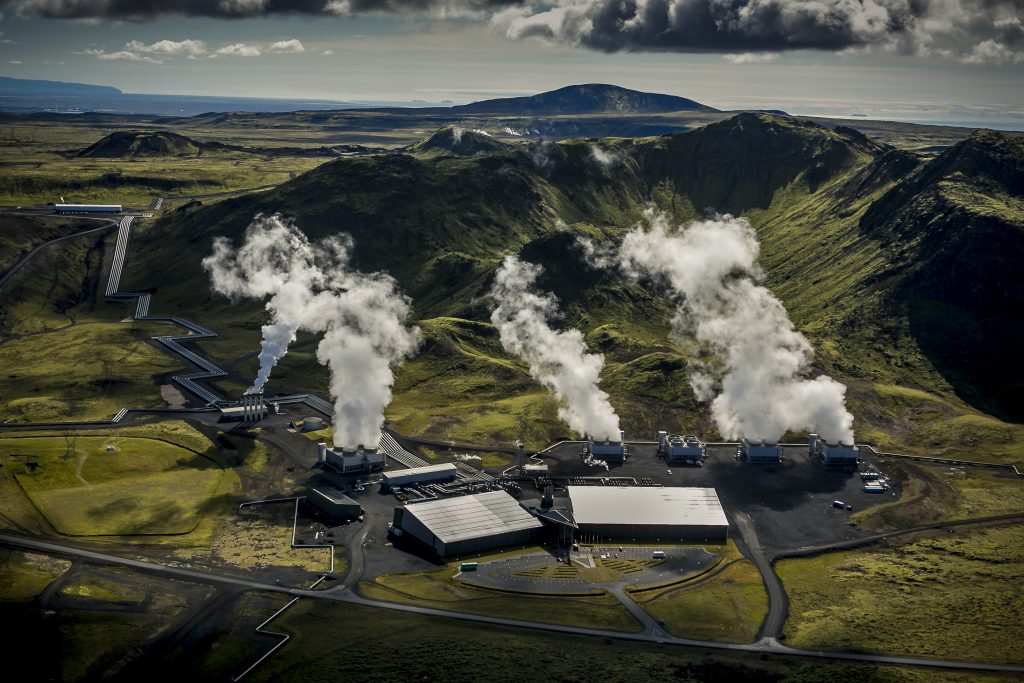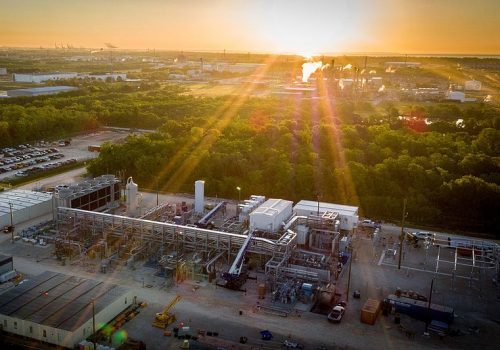Fulfilling pledges that the United States and hundreds of other countries made at the breakthrough Paris Climate Summit in 2015 calls for exponential change in how we deal with CO2. The planet currently releases around 40 gigatons of carbon into the atmosphere every year. To meet the Paris Agreement’s 1.5 degrees Celsius goal, the planet needs to reach net-zero greenhouse gas (GHG) emissions by 2050. The Biden-Harris administration has just committed to a 50+ percent reduction in CO2 from a 2005 baseline, by 2030.
While moving to new energy sources and capturing carbon emissions at the source will play a major part of this, much of the solution will still need to rely on removing carbon directly from the atmosphere. Time is of the essence and getting there will require bold, radical technology innovation and scale up, beyond just limiting emissions or capturing at the source, but also removing CO2 already in the air and oceans.
In addition to government measures, the private sector is also seeking ways to encourage innovation for carbon reduction. Launched this year on Earth Day, the $100M XPRIZE Carbon Removal contest, funded by Elon Musk, is the largest incentive prize competition in history. Its goal is to drive competition and collaboration at scale, including from non-traditional innovation sources, to accelerate existing and new gigaton carbon removal technologies. Carbon removal technology breakthroughs which will come out of this XPRIZE could be the solution to reaching the Paris Climate Agreement targets, and the cornerstone of a united push to protect the climate and Earth, and with it, the future of humanity. But for maximum impact, governments and tech will need to work together.
Reaching gigaton scale
In March 2021, House Democrats reintroduced the Climate Leadership and Environmental Action for Our Nation’s (CLEAN) Future Act, which aims to transition major sectors of the US. economy toward a “clean energy” future.
To achieve the goal of net-zero emissions by 2050, the bill proposes significant steps to reduce emissions from the industrial sector (c. 22 percent of US GHG emissions), of which the cornerstones are its “Buy Clean” and “Climate Star” programs which seek to leverage market forces to incentivize the production and purchase of low-carbon materials and products. The proposal also includes substantial investments in electrification in the transportation sector (28 percent of US GHGs) and the establishment of a federal Clean Electricity Standard (CES) to move the electricity generation sector to carbon-free emissions by 2035, consistent with President Biden’s campaign pledge.
This bill could help the United States meaningfully curb carbon emissions domestically, which is critically needed but still not enough to stop climate change. Humanity has a global problem on its hands. And experts have warned that the world need not just reduce carbon emissions, but must actively remove carbon too. Material carbon reduction requires using all the “tools” in the toolbox.
The challenge is two-fold, and extends to reducing CO2 levels in the atmosphere and eliminating CO2 emissions from anthropogenic sources, be they power, industrial or transportation. Right now, there are federal tax credits and some state-level policies that offer initial incentives to start capturing and storing CO2. Yet even with the potential establishment of a carbon price, and a mechanism for polluters to pay their fair share, we would still need new pathways to remove, sequester, and eliminate carbon at the gigaton scale. Gigaton-scale removal, capture, and storage technologies will be required and will require a myriad of available solutions across many sectors.
Carbon Capture, Utilization, and Storage (CCUS)
Carbon capture, utilization, and storage (CCUS) has received significant funding over the years from the U.S. Department of Energy (DOE), with much of the focus on novel CO2 capture and sequestration technologies and large demonstration projects, frequently pertaining to coal-fired power generation. That emphasis has now evolved to include direct air capture, natural geologic and terrestrial systems, industrial capture, and high-precision subsurface storage.
Carbon storage has also been used for decades by the oil & gas industry, with CO2 used to enhance oil recovery (EOR); much of the injected CO2 can remain in the Earth, albeit coupled with an increase in oil production. While much of this EOR is U.S.-centric, using mostly naturally occurring CO2, many have seen EOR and related infrastructure as a needed pathway towards framing “CO2 as a business.” This coupling of CO2 emissions reductions and the oil and gas industry is a difficult narrative, but it underscores and illustrates the financial and major project prowess which that sector brings to the table.
This landscape is now changing. While they have attracted limited venture or private equity funding so far, a number of new projects ranging from major industrial companies to start-ups are now trying to master carbon capture “at the source” with approaches focused on long-term, safe subsurface storage that is not in oil and gas reservoirs. The catalyst is the 45Q tax credits and the target is deep “saline” reservoirs which can ensure safe and permanent storage, building on a number of past and present DOE programs designed to address subsurface characterization and risk management. Notably, there are comparable international efforts and policies designed to streamline getting to scalable CO2 removal; Norway has been doing this for years, at the Sleipner and Snowvit offshore projects. In addition, state-level initiatives such as the California Low Carbon Fuel Standard (LCFS) offer additional potential to link low-carbon fuels with CCUS.
Air, Land, and Oceans
Natural systems are also key to the solution. Trees and biomass contribute significantly to permanently removing CO2 from the atmosphere, and there is exciting new work on the role and potential of soils, minerals, and rocks. Trees alone, however, cannot provide the sequestration capacity or rate of reduction needed to reduce existing carbon in the atmosphere and in our oceans.
Direct Air Capture (DAC) technologies, which strip CO2 directly out of the air, offer radical potential for carbon removal. But high costs, common with early-stage technologies, have prevented start-ups like Carbon Engineering (backed by Bill Gates) and Climeworks from scaling. Most DAC solutions use giant fans to capture air, and sorbents to capture the CO2. Enabling DAC to scale will require innovations that can drastically reduce DAC energy requirements to heat and cool these chemical sorbents, and can hopefully be powered entirely by renewable energy and an increasingly clean energy electric grid.
DAC also offers integrated solution opportunities, since DAC technologies require heat to remove CO2 from the sorbents. DAC can be combined with geothermal heat or energy, or with processes that lead to clean transportation fuels, for example. Furthermore, DAC can be sited almost anywhere, minimizing the need for overly expensive infrastructure and directly coupling the removal technology with the storage site. The vision of integrated, low-carbon complexes, with solar, wind, geothermal, DAC and CCUS, and hydrogen generation all being developed in a co-located system, may be right around the corner.
Carbon removal through mineralization is another promising solution, whereby CO2 is permanently converted into carbonate minerals through weathering and alteration of silicate minerals. The innovation opportunities include engineered or accelerated geologic removal, and techniques to potentially accelerate otherwise slow geochemical processes.
Finally, marine systems may also be part of the solution; the challenge is that oceans are already a major thermal and carbon sink with documented examples of adverse impacts (ecosystems, reefs etc.). Macroalgae solutions, however, warrant further research since they are especially efficient at capturing CO2, although with significant energy requirements.
CO2 as a “feedstock”
Coupled with removing or capturing CO2, progress must be made to advance ways in which CO2 can be used as a feedstock. This is difficult, since it risks using too much energy or creating too much emissions in the process. As one example, a joint-venture between Swedish start-up Liquid Wind and London-based Carbon Clean plans to capture CO2 from industrial chimneys and combine it with hydrogen to create and provide methanol fuel for the shipping industry within two years. (This provides a second re-use of the carbon before it is again released into the atmosphere.) Meanwhile, US start-up Blue Planet is developing carbon capture and mineralization processes to sequester CO2 in synthetic concrete, which was used at San Francisco International Airport.
These steps all constitute progress, but unlocking capture, utilization, and storage pathways at gigaton scale will require even further technological breakthroughs.
The devil is in the details
Carbon removal at the gigaton scale raises many questions. Chief among them, and separate from questions of stability and environmental impact are: where will the innovations come from, who will pay, and how will these innovative breakthroughs come to fruition? How can the world calibrate and balance full-scale carbon removal and economic growth? And finally, how can we ensure a seamless and efficient evolution from government and early stage R&D, to commercial update at scale?
Not all solutions will be equal when it comes to stability and environmental impact. Some, such as CO2 storage and use in oil and natural gas reservoirs, might raise conundrums and lead to difficult conversations. Occidental Petroleum CEO Vicki Hollub has stated that her company pumps more CO₂ into the ground than Tesla prevents from being emitted on roads, and contends that it stores more CO2 than the barrel of oil produced from that CO2 emits when burned. This raises an important question: how will CO2 lifecycles be monitored and verified, whether from terrestrial sequestration, commercial use, conversion or permanent subsurface disposal? Who will do the audits, and what tools and mechanisms will be needed to ensure public confidence?
Typically, government involvement is needed when market forces alone are enough to foster innovation. The U.S. has done more than any other country to identify, support, fund and commercialize these technologies. The most recent example is the 45Q tax credit, an incentive to support the deployment of carbon management projects in the United States. A key question is whether the full set of needs—technology, regulations, incentives, and infrastructure—are sufficiently aligned to ensure CO2 removal at the pace and scale needed. A concern raised by John Deutch, Institute Professor Emeritus at Massachusetts Institute of Technology, has been that projects of this size are going to be conducted by nation-states “that have simple governments,” such as China. Deutch further noted that while DOE’s Advanced Research Projects Agency–Energy program is “important because it takes you beyond just a lab or a bench scale, to more of a technology possibility, [it is] far from technology demonstration of something at the gigaton scale.” More innovative, operational projects are needed at scale, which the DOE has significant funds to support and accelerate.
But how do we inspire and incentivize gigaton scale carbon removal technology breakthroughs that could come from anyone, anywhere?
Domestic and international carbon removal policies could also play a key role, alongside the XPRIZE and other private sector initiatives, in incentivizing the development and deployment of carbon removal technologies, which will only scale with public and private backing.
But for maximum impact, the entire value chain has to work together, bridging the technical, policy, financial and operational communities.
Laetitia Garriott de Cayeux, an entrepreneur and breakthrough technologist, serves on the board of directors of XPRIZE which launched on Earth day the $100M XPRIZE Carbon Removal funded by Elon Musk, and on the advisory board of the Truman National Security Project. She is also a member of the Council on Foreign Relations, and the Economic Club of New York.
Douglas Hollett, an energy technology and policy expert, served as Principal Deputy Assistant Secretary in the Office of Fossil Energy, and before that as Deputy Assistant Secretary for Renewable Power at the Department of Energy under President Obama. His portfolios included the U.S. R&D programs in CCUS, Renewable Power and Fossil Energy.
Read more from EnergySource
Related content

The Global Energy Center develops and promotes pragmatic and nonpartisan policy solutions designed to advance global energy security, enhance economic opportunity, and accelerate pathways to net-zero emissions.
Image: The Hellisheidi Geothermal Power Plant in Iceland (Arni Saeberg, Climeworks/Wikimedia Commons)




